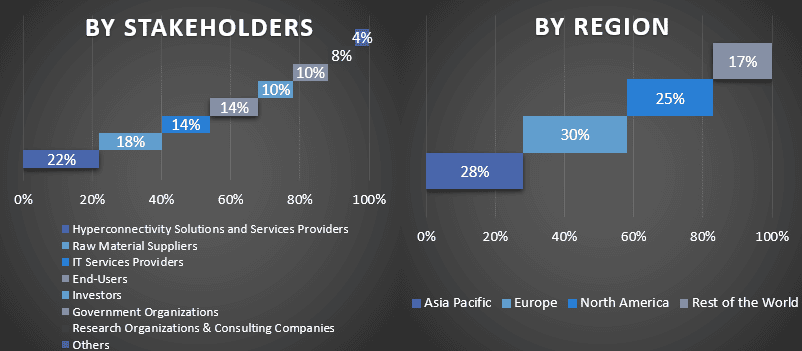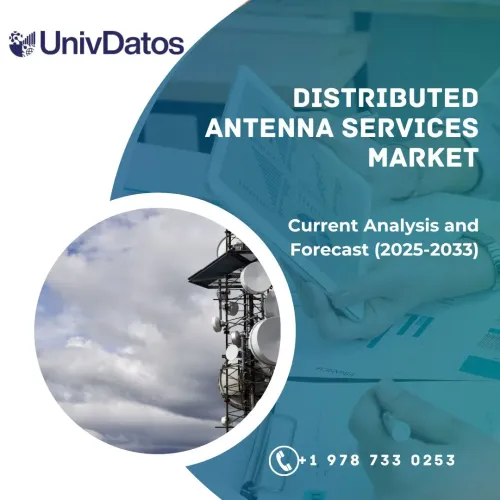- Home
- About Us
- Industry
- Services
- Reading
- Contact Us
Hyperconnectivity Market: Current Analysis and Forecast (2022-2028)
Emphasis on Component (Solutions and Services); Product (Enterprise Wearable Device, Middleware Software, Cloud Platforms, Network & Communication, and Business Solutions); Industry (Banking & Financial Services, Information & Communication Technology, Healthcare, Manufacturing, Government, and Others); and Region/Country

The Hyperconnectivity Market is expected to grow at a strong CAGR of 25.2% during the forecast period owing to the increased convenience, efficiency, and productivity of hyperconnectivity. Hyperconnectivity refers to the trend of being continuously connected to the internet and other devices through various means such as smartphones, tablets, wearables, laptops, and other smart devices. The demand for hyper-connectivity is growing rapidly due to a variety of factors. The main reason is the increasing reliance on technology for both personal and professional pursuits. For example, people are using smartphones and laptops to work remotely, take online courses, and access e-commerce websites and social media platforms. The COVID-19 pandemic has accelerated this trend as many people switched to remote work and online activities. Another reason for the growing demand for hyperconnectivity is the rise of Internet of Things (IoT) devices such as smart homes, smart cars, and other wearables that are always connected to the Internet. With the rapid development of new technologies, hyper-connectivity is expected to become even more prevalent in the future.
Some of the major players operating in the market include Oracle; Fujitsu; IBM; Iberdrola, S.A.; Microsoft; Orange Business; Cisco Systems, Inc.; General Electric; AT&T; and Verizon. Several M&As along with partnerships have been undertaken by these players to facilitate customers with hi-tech and innovative products/technologies.
Insights Presented in the Report
“Amongst components, the solutions segment held a prominent share of the market in 2021”
Based on component, the market is divided into solutions and services. Amongst these, the solutions segment catered to a dominating share of the market in 2021. This is due to technological advancements, increasing reliance on digital devices, and globalization. With the advent of new technologies such as 5G networks, the Internet of Things (IoT), and cloud computing, it has become easier to connect devices, people, and services. This has made hyperconnectivity more accessible and affordable. Hence, the demand for hyperconnectivity solutions is increasing.
“Amongst products, the cloud platfroms held a prominent share of the market in 2021”
By product, the market is segmented into enterprise wearable device, middleware software, cloud platforms, network & communication, and business solutions. The cloud platforms segment captured more than a 30% share of the hyperconnectivity market in 2021. Many enterprises are transitioning from traditional on-premise IT infrastructure to cloud-based services. This has resulted in a significant increase in demand for cloud platforms that can provide the necessary computing power, storage, and others.
“North America dominated the market in 2021”
In North America, the demand for hyperconnectivity has increased in recent years, driven by the rising adoption of digital technologies and the growing need for businesses to remain competitive in a rapidly changing market. North America has one of the world’s largest populations of internet users, with the rapid spread of smartphones and IoT devices. This is creating greater connectivity between people and devices, creating new opportunities for growth and innovation. In addition, with a strong ecosystem of digital technology providers, a highly skilled workforce, and favorable regulatory policies, the region is well-positioned to capitalize on this trend.
Reasons to buy this report:
- The study includes market sizing and forecasting analysis validated by authenticated key industry experts.
- The report presents a quick review of overall industry performance at one glance.
- The report covers an in-depth analysis of prominent industry peers with a primary focus on key business financials, product portfolios, expansion strategies, and recent developments.
- Detailed examination of drivers, restraints, key trends, and opportunities prevailing in the industry.
- The study comprehensively covers the market across different segments.
- Deep dive regional level analysis of the industry.
Customization Options:
The global hyperconnectivity market can further be customized as per the requirement or any other market segment. Besides this, UMI understands that you may have your own business needs, hence feel free to connect with us to get a report that completely suits your requirements.
Table of Content
Research Methodology for the Hyperconnectivity Market Analysis (2022-2028)
Analyzing the historical market, estimating the current market, and forecasting the future market of the global hyperconnectivity market were the three major steps undertaken to create and analyze the adoption of hyperconnectivity in major regions globally. Exhaustive secondary research was conducted to collect the historical market numbers and estimate the current market size. Secondly, to validate these insights, numerous findings and assumptions were taken into consideration. Moreover, exhaustive primary interviews were also conducted, with industry experts across the value chain of the global hyperconnectivity market. Post assumption and validation of market numbers through primary interviews, we employed a top-down/bottom-up approach to forecasting the complete market size. Thereafter, market breakdown and data triangulation methods were adopted to estimate and analyze the market size of segments and sub-segments of the industry pertains to. Detailed methodology is explained below:
Analysis of Historical Market Size
Step 1: In-Depth Study of Secondary Sources:
Detail secondary study was conducted to obtain the historical market size of the hyperconnectivity market through company internal sources such as annual reports & financial statements, performance presentations, press releases, etc., and external sources including journals, news & articles, government publications, competitor publications, sector reports, third-party database, and other credible publications.
Step 2: Market Segmentation:
After obtaining the historical market size of the hyperconnectivity market, we conducted a detailed secondary analysis to gather historical market insights and share for different segments & sub-segments for major regions. Major segments are included in the report as component, product, and industry. Further country-level analyses were conducted to evaluate the overall adoption of testing models in that region.
Step 3: Factor Analysis:
After acquiring the historical market size of different segments and sub-segments, we conducted a detailed factor analysis to estimate the current market size of the hyperconnectivity market. Further, we conducted factor analysis using dependent and independent variables such as component, product, and industry of the hyperconnectivity market. A thorough analysis was conducted for demand and supply-side scenarios considering top partnerships, mergers and acquisitions, business expansion, and product launches in the hyperconnectivity market sector across the globe.
Current Market Size Estimate & Forecast
Current Market Sizing: Based on actionable insights from the above 3 steps, we arrived at the current market size, key players in the global Hyperconnectivity market, and market shares of the segments. All the required percentage shares split, and market breakdowns were determined using the above-mentioned secondary approach and were verified through primary interviews.
Estimation & Forecasting: For market estimation and forecast, weights were assigned to different factors including drivers & trends, restraints, and opportunities available for the stakeholders. After analyzing these factors, relevant forecasting techniques i.e., the top-down/bottom-up approach were applied to arrive at the market forecast for 2028 for different segments and sub-segments across the major markets globally. The research methodology adopted to estimate the market size encompasses:
- The industry’s market size, in terms of revenue (USD) and the adoption rate of the Hyperconnectivity market across the major markets domestically
- All percentage shares, splits, and breakdowns of market segments and sub-segments
- Key players in the global Hyperconnectivity market in terms of products offered. Also, the growth strategies adopted by these players to compete in the fast-growing market
Market Size and Share Validation
Primary Research: In-depth interviews were conducted with the Key Opinion Leaders (KOLs) including Top Level Executives (CXO/VPs, Sales Head, Marketing Head, Operational Head, Regional Head, Country Head, etc.) across major regions. Primary research findings were then summarized, and statistical analysis was performed to prove the stated hypothesis. Inputs from primary research were consolidated with secondary findings, hence turning information into actionable insights.
Split of Primary Participants in Different Regions

Market Engineering
The data triangulation technique was employed to complete the overall market estimation and to arrive at precise statistical numbers for each segment and sub-segment of the global hyperconnectivity market. data was split into several segments & sub-segments post studying various parameters and trends in the areas of the component, product, and industry in the global hyperconnectivity market.
The main objective of the Global Hyperconnectivity Market Study
The current & future market trends of the global hyperconnectivity market were pinpointed in the study. Investors can gain strategic insights to base their discretion for investments on the qualitative and quantitative analysis performed in the study. Current and future market trends determined the overall attractiveness of the market at a regional level, providing a platform for the industrial participant to exploit the untapped market to benefit from a first-mover advantage. Other quantitative goals of the studies include:
- Analyze the current and forecast market size of the hyperconnectivity market in terms of value (USD). Also, analyze the current and forecast market size of different segments and sub-segments
- Segments in the study include areas of the component, product, and industry
- Define and analysis of the regulatory framework for the hyperconnectivity industry
- Analyze the value chain involved with the presence of various intermediaries, along with analyzing customer and competitor behaviors of the industry
- Analyze the current and forecast market size of the hyperconnectivity market for the major region
- Major countries of regions studied in the report include Asia Pacific, Europe, North America, and the Rest of the World
- Company profiles of the Hyperconnectivity market and the growth strategies adopted by the market players to sustain in the fast-growing market
- Deep dive regional level analysis of the industry
Related Reports
Customers who bought this item also bought










